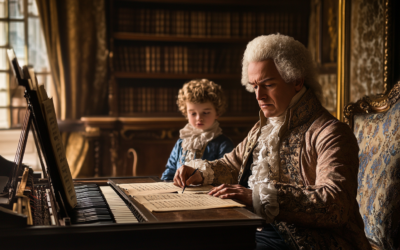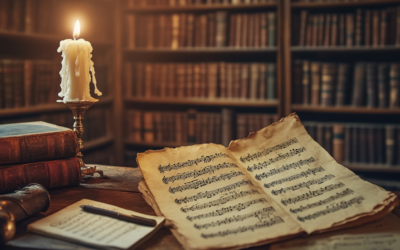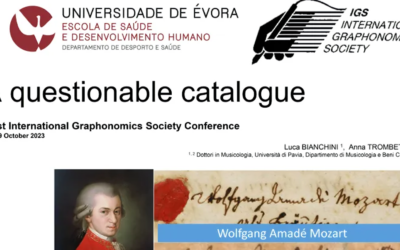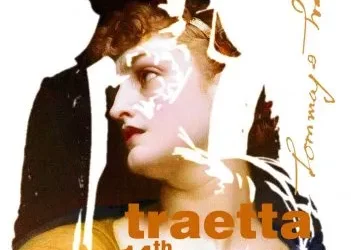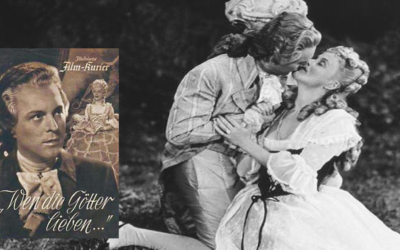The Questionable Origins of Mozart’s Violin Concertos
A Closer Look at the Ambiguities and Influences
Mozart’s first five violin concertos, composed in just eight months during 1775, present numerous contradictions, from unclear dates on manuscripts to varying levels of technical difficulty. These inconsistencies raise doubts about the true origins of these works.
Could Josef Mysliveček, a contemporary of Mozart, have provided more than just inspiration? Was Mozart’s “genius” merely an appropriation of ideas from those around him?
This article examines these questions, focusing on the stylistic similarities between the concertos and the works of Mysliveček.
Mozart: The Fall of the Gods
This book compiles the results of our studies on 18th-century music and Mozart, who has been revered for over two centuries as a deity. We dismantle the baseless cult of Mozart and strip away the clichés that falsely present him as a natural genius, revealing the contradictions in conventional biographies. In this work, divided into two parts, we identify and critically analyze several contradictory points in the vast Mozart bibliography. Each of the nearly 2,000 citations is meticulously sourced, allowing readers to verify the findings. This critical biography of Mozart emerges from these premises, addressing the numerous doubts raised by researchers.
"The undeniable influence of Mysliveček on Mozart’s violin concertos leaves one to wonder where genius ends and imitation begins."
Mozart: The Fall of the Gods
Contradictions in Manuscripts and Dates
The first five violin concertos attributed to Mozart—K.207, K.211, K.216, K.218, and K.219—are said to have been written between April and December 1775. Yet, the manuscripts tell a different story. The date for K.207, for example, appears multiple times on the autograph, suggesting “April 13, 1775,” “April 14, 1775,” or even “April 1780.” The numerous revisions of dates raise suspicion about when—and perhaps by whom—these works were truly composed.
Adding to the confusion is the absence of any commissioner for the concertos. These were not works requested for a particular occasion, which was unusual for Mozart, a composer who rarely wrote without a specific purpose. Moreover, the varying technical difficulty and style within the set of five concertos suggest inconsistencies not typical of a singular composer working on a cohesive project.
The Influence of Josef Mysliveček
It is impossible to ignore the role that Josef Mysliveček may have played in these works. Mozart met the Czech composer during his Italian travels, and their friendship endured until around 1778. Mysliveček’s influence on Mozart is particularly evident in K.207, which bears striking resemblances to his earlier compositions. The syncopated opening of K.207 mirrors Mysliveček’s style, and the structure of its movements closely follows the standard forms found in Mysliveček’s violin concertos.
Notably, Wolfgang Plath, a 20th-century Mozart scholar, suggested that K.207 might have been written as early as 1773, based on an analysis of the paper used for the autograph. However, even if we accept this earlier date, the question remains: how much of Mozart’s first violin concerto is truly his?
Borrowing or Imitation?
The similarities between Mozart’s violin concertos and those of Mysliveček extend beyond K.207. In fact, K.211, known as the “Concerto facile,” and K.218 also exhibit clear influences from Mysliveček’s compositions. Several phrases from these concertos reappear in Mozart’s later works, including his serenade Il Re Pastore.
Mozart himself acknowledged this practice of borrowing, as evidenced by a letter in which he humorously mentioned copying the title page of one of Mysliveček’s concertos. But did the borrowing stop at the title page? The resemblances between the two composers’ works suggest that Mozart, still learning the ropes of concerto composition, leaned heavily on his friend’s established mastery.
The Legacy of Collaboration
While some may argue that Mozart’s borrowings were merely a tribute to Mysliveček’s genius, others suggest a more collaborative relationship between the two. As musicologist Giuseppe Rausa theorizes, the two composers may have exchanged favors, with Mysliveček gifting Mozart some of his works in exchange for assistance with commissions in Salzburg.
If so, what does this say about the authorship of works like K.216, often hailed as a masterpiece? The structure and virtuosic demands of K.216 align more closely with Mysliveček’s style than with Mozart’s early works. Could this celebrated concerto have been more an act of appropriation than of creation?
You May Also Like
K.143: A Recitative and Aria in the Shadows of Doubt
K.143 is a prime example of how Mozart scholarship has turned uncertainty into myth. With no definitive evidence of authorship, date, or purpose, this uninspired recitative and aria in G major likely originated elsewhere. Is it time to admit this is not Mozart’s work at all?
The Enigma of Mozart’s Symphony K.73
The Symphony in C Major K.73 has long puzzled Mozart scholars. Touted as a youthful work of prodigious talent, its origins are murky at best. The title “Symphony,” inscribed on the first page of the autograph, is devoid of the composer’s name, casting immediate doubt on its attribution to Wolfgang Amadeus Mozart. Was this truly his work, or is the Symphony yet another victim of overzealous attribution?
Mozart’s Thematic Catalogue Exposed as a Forgery
A groundbreaking forensic analysis reveals that Mozart’s thematic catalogue, long thought to be his own work, is a posthumous forgery. This discovery, detailed in Mozart: The Construction of a Genius, turns centuries of Mozart scholarship on its head, demanding a re-examination of his legacy.
Bologna Connections
Quirino Gasparini’s rediscovered Mitridate aria takes centre stage in Bern and Basel, shedding light on Mozart’s reliance on this forgotten composer.
International Traetta Award
We are thrilled to announce that the 14th International Traetta Award has been bestowed upon Anna Trombetta and Luca Bianchini. This prestigious recognition honours their outstanding dedication to musicological research on primary sources of the European musical repertoire, offering significant contributions to reshaping the historiography of 18th-century music.
A Legacy Rewritten by the Shadows of History
Mozart’s image, often regarded as a universal symbol of musical genius, was heavily manipulated by the Nazi regime, a fact largely ignored in post-war efforts to “denazify” German culture. From propaganda-driven films to anti-Semitic narratives, Mozart’s legacy is far more complex and troubling than we are often led to believe.


